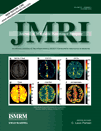Quantitative BOLD: The effect of diffusion
Abstract
Purpose:
To make the quantitative blood oxygenation level-dependent (qBOLD) method more suitable for clinical application by accounting for proton diffusion and reducing acquisition times.
Materials and Methods:
Monte Carlo methods are used to simulate the signal from diffusing protons in the presence of a blood vessel network. A diffusive qBOLD model was then constructed using a lookup table of the results. Acquisition times are reduced by parallel imaging and by employing an integrated fieldmapping method, rather than running an additional sequence.
Results:
The addition of diffusion to the model is shown to have a significant impact on predicted signal formation. This is found to affect all fitted parameters when the model is applied to real data. Parallel imaging and integrated fieldmapping allowed the GESSE (gradient echo sampling of a spin echo) acquisition to be made in less than 10 minutes while maintaining high signal-to-noise ratio (SNR).
Conclusion:
By incorporating integrated field mapping and parallel imaging techniques, GESSE data were acquired within clinically acceptable acquisition times. These data fit closely to the diffusive qBOLD model, providing more realistic and robust measurements of T2 and blood oxygenation than the static model. J. Magn. Reson. Imaging 2010;32:953–961. © 2010 Wiley-Liss, Inc.




